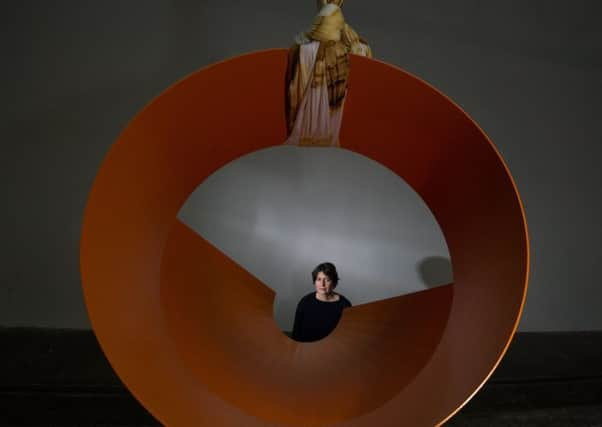Art reviews: Between The Poles and Tides | Kate V Robertson | Claire Barclay


Between Poles and Tides ***
Kate V Robertson: Object(hood) ***
Both at Talbot Rice Gallery, Edinburgh
Claire Barclay: Yield Point *****
Tramway, Glasgow until
The merger between Edinburgh College of Art and the University of Edinburgh in 2011 was precipitated by ECA’s financial crisis rather than coherent planning. Yet five years on, under new management, it has been an unequivocal success. Each institution has been academically and culturally enriched and Edinburgh’s teaching and research community in art and design has widened and strengthened.
Another benefit, on show now at Talbot Rice Gallery, has been the return to Edinburgh University of active public collecting. Artists exhibiting at Talbot Rice, graduates from ECA’s degree programmes and the increasingly confident Edinburgh art community are all represented in Between Poles and Tides an exhibition showcase of the University’s newly-strengthened collections. If the themes are wide, most of the artists form a conversation with other academic disciplines: Ilana Halperin has long worked with geologists and vulcanologists to mine the metaphoric possibilities of the natural world. Her sculpture Physical Geology (cave cast/slow time) was created in tandem with natural forces, in this case by the steady accretion of limestone in the caves of Fontaines Pétrifiantes in France where stalactites form at alarming rates. Daisy Lafarge’s film Not For Gain uses film of specimen plants in what I’m guessing must be the Royal Botanic Garden for the basis of a dystopian essay on plant-breeding and selection as a timely metaphor for migration, citizenship and national borders. Jessica Harrison’s eye-catching ceramics, bring a fresh shine to Royal Doulton figurines with tiny tattoos and modifications that are sweetly subversive.
Advertisement
Hide AdAdvertisement
Hide AdAs part of this fresh breath of life in the university’s wider collection, the artist Kate V Robertson interrogates the question of collections altogether. Each week she displays an object from the University’s collections upstairs in TRG3 along with a recording of both experts and amateurs as they discuss its origins and appearance. Her first object, when I visited, was a charming “Brain Coral” an enigmatic and beautiful thing that deserves Robertson’s suggestion that inanimate objects often seem to have sentient life of their own.
Robertson, like many younger sculptors in Scotland, may owe a familial debt to the Glasgow artist Claire Barclay. It is a mark of Barclay’s importance that not only is her steady persistence in exploring form and craft an abiding influence on emerging artists, but her perceptive art tells us much about our times.
A quick recollection of her work over the last three decades, from representing Scotland at the Venice Biennale in 2003 to her showstopper at the Kelvin Hall at the GI Festival last year now reads like a neat summary of the zeitgest.
Barclay’s investment in hands-on making, her feminism and a certain attention to the textures of the past made her a singular voice in Glasgow’s male-dominated nineties after she graduated from Glasgow School of Art’s sculpture Environmental Art Department in 1990. In subsequent decades her intelligence has delineated a smart skewering of the culture and purpose of making in the post-industrial age. Her use of suede, feather and leather has been an interrogation of our cultural squeamishness about our true exploitative relationship with the animal kingdom. Her interest in weaving, macramé and ceramics an investigation of our desire for craft and authenticity in the digital era, her use of machine-tooled metal parts conveyed an early understanding of how the age of industrialisation has become a heritage commodity and on a memorable occasion she has even taken a brisk pop at our love for the gym.
Quite how the artist achieves this, is hard to describe. Barclay’s art work is less sculpture than a method of evocation and accrual, using handmade, crafted and machine made objects she assembles and evokes the material world rather than representing it. Her hands command a precise, and deeply sensual world and her mind exercises a keen conceptual watch over the meanings we make of it.
It’s a cliché to describe a major show as an artist’s largest yet. At Tramway the scale of Barclay’s work in the vast space is astounding without ever slipping into the gargantuan for the sake of it. For more than a month Barclay has treated the vast industrial space as studio and workshop, exhibition space and display. The result is her most fully-realised single work, an exhibition that is part factory, part machine and still a single installation.
Vast slips of beige latex hang from black-forged butchers’ hooks, descending from the gallery roof, like so many flayed carcasses. A huge orange canvas parachute is suspended from the ceiling and lit to show the spools of wool within. Fine leather gauntlets and brass fingers decorate a cage of metal.
Advertisement
Hide AdAdvertisement
Hide AdDrainage funnels or rubbish chutes, hang from the ceiling. Barbells and rubber loops suggest the inner workings of a machine and the humdrum inevitability of the conveyor belt. But amongst these large gestures, precision is everywhere. A poured concrete platform contains a shallow basin scoured by finger marks that have gouged out the surface. Low trays contain grease. A shallow bowl is filled with melted soap. White slip cast ceramics are coated in smoke like so many industrial lungs.
There is something of the barn or the abattoir as much as the textile factory in Yield Point. Barclay suggests a body at breaking point as much as the broken dreams of Glasgow’s great industrial history. It is a melancholy triumph and one of the most memorable shows the venue has hosted. ■
Between Poles and Tides until 9 May; Kate V Robertson: Object(hood) until 8 April; Claire Barclay: Yield Point until 9 April